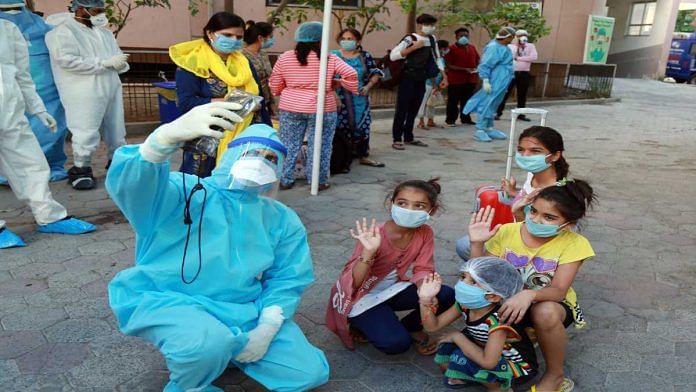New Delhi: Six states/union territories, including Delhi and Maharashtra, make up for around 80 per cent of India’s Covid-19 cases, according to an analysis by the Modi government accessed by ThePrint.
The analysis, which sought to assess the trends of the pandemic in the country, was shared by the government with states/union territories Thursday.
The other states in the list are Tamil Nadu, Gujarat, Rajasthan and West Bengal. According to the data, five states/union territories constitute 82 per cent of India’s Covid-19 deaths — Maharashtra, Delhi, Gujarat, West Bengal and Madhya Pradesh.
The analysis, which factors in data until 9 June, reveals a mixed picture vis-a-vis India’s Covid-19 response. While India’s case fatality ratio (CFR) — the number of patients who die, as a percentage of those who test positive — has been constant at 2.9 per cent, the data suggests the doubling rate, which refers to the period in which the number of cases doubles, increased to 16.9 days, from 14.1 days, over the past two weeks.
However, the assessment has yielded some worrying findings. For one, the government has noted an increase in the confirmation rate (CR), which is the percentage of persons testing positive for every 100 samples tested, over the past two weeks. The trend witnessed in some of the states, including Goa and seven of the eight northeastern states, evokes concern too.
The government has dispatched its assessment with an action plan meant to preempt any surge in the number of high-risk patients. The strategies suggested include increased testing and sorting out patients on the basis of their criticality to ensure the most severely-affected get immediate care.
Also Read: Maharashtra has highest number of Covid cases in India, but is fifth in terms of fatalities
‘CFR flat’
According to the government data, India’s CFR for Covid-19 has largely remained flat at 2.9 per cent since the time it was first calculated in the country. It rose marginally to 2.96 per cent but was brought down again over the past two weeks, which suggests better clinical management of patients.
Another positive indicator is the increasing doubling rate. The data shows that the doubling rate for India increased to 16.9 days, from 14.1 days, over the past two weeks.
Worrying trend
The worrying aspects include an increase in the confirmation rate (CR), which rose to 5.7 per cent over the past two weeks, from 4.87 per cent. This, the government said, indicates either a “spread of infection or less testing”.
Also, as many as 69 districts in India have a CFR of more than 5 per cent, most of them situated in Madhya Pradesh, Uttar Pradesh, Maharashtra and Gujarat.
The doubling rate in Chhattisgarh, Manipur and Goa has been recorded at less than seven days, which means the cases here are increasing rapidly.
The “epicentres” of the coronavirus outbreak, according to the central government’s analysis, are largely urban areas with more than 600 cases. These areas are spread over 23 districts, most of them in Delhi, Maharashtra, Tamil Nadu and West Bengal.
As many as 72 per cent of India’s active cases are concentrated in 30 districts, which account for 98,571 among India’s 1.37 lakh active cases.
“Mumbai, Chennai, Thane, Ahmedabad, Pune, Chengalpattu, Gurugram, Kolkata, Hyderabad and five districts in Delhi account for more than 60 per cent (83,271 cases) of the total active caseload,” the central government has told state and union territory governments.
Beyond these epicentres, 98 districts have been identified as having become “significantly infected” in the last three weeks.
The government has noted a “significant spread” in seven northeastern states, Manipur, Assam, Mizoram, Arunachal Pradesh, Meghalaya, Tripura and Sikkim, where 53 districts have registered Covid-19 infections. A similar trend has been observed in the eastern states of Chhattisgarh, Odisha, Jharkhand and West Bengal.
Also Read: Why Delhi’s Covid patients are running from pillar to post in search of a hospital bed
Action plan
The action plan accompanying the assessment lists strategies such as containment of disease through strict perimeter control, active house-to-house surveillance through special teams for early identification of cases, and community-led surveillance in highly affected districts.
The guidelines for “testing and tracing” focus on early testing of high-risk contacts in states and districts with a heavy case load, and clinical triaging (sorting patients on the basis of immediacy of treatment required) at facilities.
Preventive measures and active surveillance and testing have been advised, especially for vulnerable populations, with an objective of reducing “high-risk patient count and improving speed-to-care”.
‘Emerging’ districts of concern
There are other findings of the assessment too. For example, the government has identified some areas as “emerging districts of concern”. According to the government’s yardstick, a district qualifies as such if it has over 400 cases, and 50 per cent of those were recorded after the easing of restrictions on 18 May.
These districts, the data shows, are concentrated in the seven states/union territories of Maharashtra, Rajasthan, Tamil Nadu, West Bengal, Karnataka, Jammu & Kashmir, and Haryana
In four districts, Gurugram (Haryana), Udupi and Yadgir (Karnataka) and Kolhapur (Maharashtra), 90 per cent of the cases were recorded after 18 May.
Also Read: Cases, fatality rate or deaths per million, India in control of Covid: Niti Aayog expert



